#Velociraptor antirrhopus
Explore tagged Tumblr posts
Text

"The sickle-clawed theropod Velociraptor antirrhopus in a fast run. The 1960s discovery of this obviously agile and birdlike predatory dinosaur helped spur the dinosaur revival we are enjoying today. Like a bird, Velociraptor could tightly fold its forelimbs."
From "Predatory Dinosaurs of the World" (1989), written & illustrated by Gregory S. Paul.
20 notes
·
View notes
Text
Alright some more art. This one is of the kitchen scene from Jurassic Park of the Velociraptor Antirrhopus. However, they are scientifically accurate. Yeah I know the human isn't the best I think I focused in more on the dinosaurs than the human lol.

#jurassic park#jurassic park kitchen scene#jurassic park velociraptor#jurassic park scientifically accurate#jurassic park scientifically accurate velociraptor#velociraptor#velociraptor antirrhopus#deinonychus#deinonychus antirrhopus#dinosaur#dinosaur art#jurassic park fanart#fanart#artist#digital artist#art#digital art#feathered dinosaurs#scientifically accurate dinosaur
3 notes
·
View notes
Text

DinoPark Tycoon (1993) for this Raptor Summer Saturday! "Don't get the idea that this is a takeoff on the movie Jurassic Park. Kephardt says the program was in the making long before the movie hit the theater."
but the film was also in the making long before it hit theaters: filming began nearly a year before release! which in early 90s video game years is...still shorter than a lot of games took to make. of course, the jurassic park novel did come out in 1990, and the film was in pre-production for 25 months before filming even began...
#DinoPark Tycoon#1993#dino park#dos#deinonychus#die-NON-ee-kus#raptor summer saturdays#speed: excellent#attack: excellent#simulation game#endVrance: excellent#move the joystick#this dino looks like it goes grr instead of rawr#Deinonychus antirrhopus#also known as:#Velociraptor antirrhopus
0 notes
Text
youtube
In this video essay, I argue that the familiar Jurassic Lore that Michael Crichton read Gregory S. Paul's "Predatory Dinosaurs of the World" (1988) which led him to synonymize "Deinonychus" with "Velociraptor," is not the TRUE source of Crichton's inspiration. Rather, thanks to a comment from terrific paleoartist Douglas Henderson during an interview for Episode 27 of the Juras-Sick Park-Cast, I believe Crichton's inspiration dates back further to 1986, when Crichton visited the most influential paleoart exhibition to date, "Dinosaurs Past and Present." Hear me out, and see what you think.
#jurassic park#novels#MichaelCrichton#Velociraptor#deinonychus#dinosaurs#nomenclature#antirrhopus#Predatory Dinosaurs of the World#Dinosaurs Past and Present#1980s#1990s#prehistory#Jurassic Lore#Gregory S. Paul#Greg Paul#Douglas Henderson#Paleoartists#paleoart#Youtube
1 note
·
View note
Text

New Spinosaurus has dropped, so therefore, I must ramble on how much I love this design over the 3rd movies design.
Disclaimer; I only recently started watching the Jurassic movies, I didn't grow up watching this so I don't have the nostalgia many people have. Therefore my opinions will be coming from up-to-date scientific research.
Firstly I love how long the bodies appear, and I am in love with how the sail isn't just a semi-circle. I've just hated how short it is compared to the body, the water scenes didn't make sense when I watched JP3 because being this stubby wouldn't have assisted it in the water.

I know this design was accurate for the time, but I just didn't really like it. I did like how it utilized its long muzzle to grab prey animals in small spaces (mainly the scene with the plane).
The air shot of the leaked Spinosaurs leaked quite a lot in my opinion though. There are three Spinos which I am going to guess will give us pack behaviors, with the intelligence the original Spinosaurus showed I'm wondering how their pack dynamic will work, my hypothesis is that they will be siblings, or some sort of family. In JP3 there are cut scenes of one of the mercenaries killing the Spinosauruses children (idk where they are, this is something I've heard), so I want to see a family dynamic.

Taking a close look at this Spinosaurus we can see most of it's body. This Spinosaurus is long, and seems to have a very thin tail which would suggest that their changing Spinosaurus from a pursuit predator (on land at least) to an ambush hunter. I also love how much care was put into making the sail seem more natural, and it seems to stretch onto the tail which is, of course, in my opinion, absolutely fabulous. It seems their going to be giving us colorful sails too, we can't see the other twos sails very well but it seems this yellow and brown one is the most complicated. With the fact that the Spinosaurs are circling a boat I believe were going to be getting a proper water chase scene.

This image reminds me of how the Mosasaurus would jump out of the water, and so I'm curious on how this scene will go down. I believe that these are two shots very close to each other. Maybe the Spinosaurs manage to sink the boat so they call in backup from a helicopter?
I also think there's a very high chance were getting a sub species of Spinosaurus, like Oxalaia. So there will be technically two Spinosaurus species.
With this hypothesis I'm also hoping that they'll have two species of Velociraptor. Velociraptor Antirrhopus (Deinonychus, the current Velociraptors) and Velociraptor Mongoliensis. If they add in Velociraptor Mongoliensis they have a chance to do pack behaviors again, and with the intelligence Velociraptor Antirrhopus shows, these tiny feathery fiends could be terrifying. Think about how Compies are underestimated because their small, but they have been shown to kill adults. Now imagine a bunch of Velociraptors chasing someone down and eating them alive. Size doesn't matter, small dinosaurs can still be terrifying and cute!
#spinosaurus#spinosauridae#velociraptor#deinonychus#jurassic park#jurassic world rebirth#Rebirth leaks#I swear to God I can ramble about how much I hate JP3 Spinosaurus for hours on end#New designs#God I fucking hate JP3 Spinosaurus#JP3 Spino needs to go die in a hole#jurassic park 3#Jurassic Park 3 rant#Make accurate Velociraptors#Save Velociraptors reputation#Velociraptor isn't a scaly beast
44 notes
·
View notes
Text
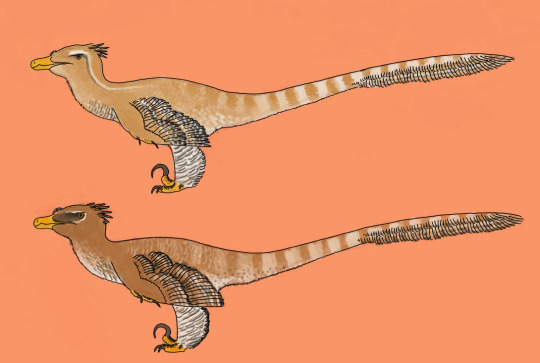
Impressions on the two main species of Velociraptor, which lived in Central Asia from about 75-71 million years ago and is arguably the most famous dromaeosaurid next to Deinonychus antirrhopus; V.mongoliensis from the Djadochta Formation at the top and V.osmolskae from the Bayan Mandahu Formation at the bottom
#velociraptor#dinosaurs#paleoart#dinosaur#dromaeosauridae#dromaeosaur#paleontology#late cretaceous#cretaceous
229 notes
·
View notes
Text

i woke up in a cold sweat with this cursed AU for MCSM. this is my contribution as a paleontology nerd, i’m so sorry in advance
stupid AU where everything is the same, but everyone is a raptor of some kind. i am such a nerd that i legitimately put thought into what type of dinosaur each character would be and why, and i’ll give explanations for each one. this was stupid and really rushed, but it was so much fun to do, and i hope you all enjoy???
—————————————-

let’s start with Jesse, who was the second easiest choice behind Axel; they are a speculative smaller subspecies of Deinonychus antirrhopus.
Deinonychus was one of the most important discoveries in paleontology, and would give rise to what is known as “the Dinosaur Renaissance”, which sparked how we see dinosaurs today. this was because of it’s clear appearance as an agile, active predator (which is not how dinosaurs were seen at the time of its discovery), and later, it’s striking resemblance to the feathered, gliding dinosaur Archaeopteryx. Deinonychus even modeled how the “Velociraptors” looked in Jurassic Park! however, the issue lies in the fact that Deinonychus was a medium-sized raptor, and Jesse… well, they’re not very tall. i really wanted to use Deinonychus, but the size wasn’t right, so i settled for a speculative, smaller subspecies. Deinonychus is also speculated to be a pack hunter, which would definitely work in Jesse’s favor. also i think it’s funny; Deinonychus antirrhopus means “counterbalanced terrible claw”, and i find that to be the most ironic thing for Jesse, given how clumsy they are. i love it.
———————————————
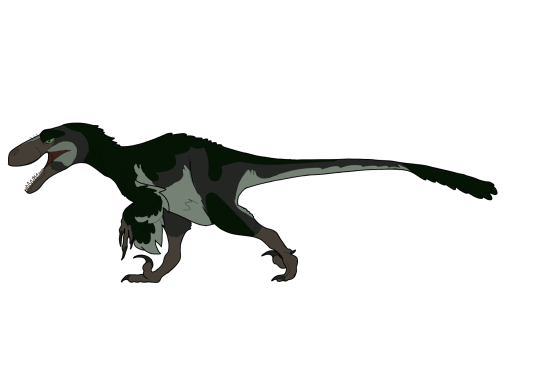
next, Axel! he was the EASIEST choice by far; he is a Utahraptor ostrommaysorum.
you probably already know Utahraptor; it’s the largest and most heavily built of all raptors, often growing just over 6 ft tall at the hips. Axel is also very tall and heavily built, so that immediately clicks. but adding on to this, in contrast with other raptors, Utahraptor was likely more of an ambushing raptor rather than a pursuit raptor, and that clicks with Axel hating running and relying on more aggressive and explosive tactics, so to speak. and finally, the most funny detail; if you’ll notice, the Utahraptor’s lower jaw juts out slightly and curves away from the upper jaw. this was probably to gain a better grip on prey, but it does give them a very strange look even when their mouth is closed. it makes that comment that Lukas made about Axel being a mouth breather even funnier, at least to me.
————————————-
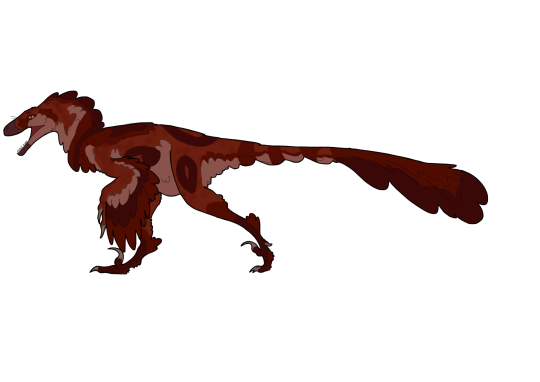
Olivia! i had a little bit of trouble with her, but i think i settled on a good one; she is a Dromaeosaurus albertensis.
Dromaeosaurus was a shier, smaller raptor that lived up north in what is now Canada, enduring freezing polar winters and months of total darkness. it’d take a lot of brains to be able to pull strings to survive that, which Olivia certainly provides. Dromaeosaurus also relied more on the chase and brain power, rather than brute force, though they would’ve if needed be. recent studies also show that raptors probably had very similar capabilities to modern birds, so if they had a brain kind of like corvids, they could’ve even used primitive tools at times. comes in handy with redstone, eh? Dromaeosaurus was also a good tracker, thanks to its sensitive nose and sharp eyes. also, they’re very important but often overlooked. Dromaeosaurus was the leading dinosaur for the names of all under the “raptor” umbrella; the dromaeosaurids.
————————————

Petra! she’s my favorite character, i’ll just admit that lmao. but i gave her the same treatment as everyone else here, so; she is an Austroraptor cabazai.
Austroraptor was a tall, lean, and quick raptor which inhabited the warm swamps of South America. obviously, Petra is the second tallest in The New Order, and Austroraptor was the second tallest raptor on record, so that checks out. but i think the build of Austroraptor checks out too; it’s moderately built, both for speed and strength, with the classic claw. it was very slender and judging from their leg bones, could be a very good pursuit raptor that could also maintain speeds for extended periods of time, which matches Petra’s love to race and run. what sets Austroraptor apart, however, is it’s diet; it was speculated to be at least partially piscivorous, meaning it ate a lot of fish. it’s teeth were slightly conical and acted almost like hooks, which would be quite painful to an opponent. Austroraptor was pretty good at it’s niche, but it wasn’t afraid to go elsewhere if needed. And Petra loves to go elsewhere.
—————————-

Lukas! he was a little tricky for me to figure out, i’m not gonna lie. i was stuck between these two: Velociraptor mongoliensis and Saurornitholestes langstoni. but i had to choose only one, and i ultimately had to go with a speculative larger subspecies of Velociraptor, since i already broke the size rule with Jesse.
Velociraptor is the most widely known, famous, and beloved raptor of all time, and obviously a fan favorite, so that already checks a box. but adding to this, Velociraptor is a very well-documented dinosaur with some incredible specimens. Velociraptors were also likely to be stealthy and tenacious hunters who used their brains, speed, and ability to take a tumble (which Lukas does a LOT) to their advantage. Lukas is also confirmed in game to be attractive (which is still so funny to me), so i added all kinds of cool looking display feathers in a blue color, because 1) his text and eyes are a blueish color and 2) blue is a kinda rare color in nature, and a lot of birds today seem to like the it. also, in episode 7, remember how his nose wasn’t right in the portrait? i kind of like to imagine that Cassie heard that he was a Velociraptor and assumed he was the Jurassic Park version? so Lukas just comes in, sees the portrait, and is like “where tf are my feathers”
——————-
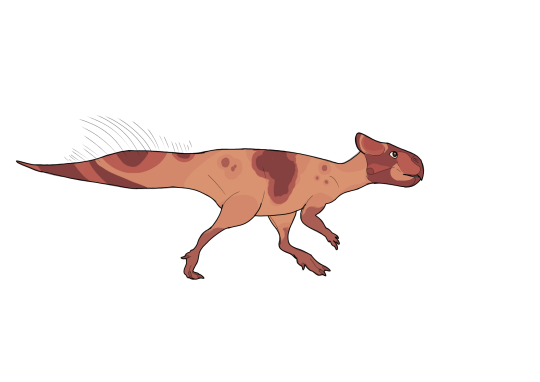
last but not least; Rueben! i had some trouble picking out a genus and species, but i knew immediately that he had to be a small ceratopsian. i chose for him, Microceratus gobiensis.
Microceratus is an adorable looking ceratopsian that was only about the size of a very small dog. but don’t let it’s appearance fool you. ceratopsians have some of the biggest characters and presences in paleontology, with the audacity to match. Rueben definitely has character, personality, and audaciousness. don’t get me wrong, they would probably rather not fight (at least some of them. can’t say the same for Triceratops), but they sure would’ve if they had to. Microceratus doesn’t have a ton of defenses, but it did have a sharp, crushing beak, and could dodge and run very quickly if it had to. it’s front legs were a bit shorter than it’s hind legs, which allowed it to run bipedally. i also just generally think of ceratopsians like the wild boars and rhinos of the dinosaur world, so i guess that just fits, considers Rueben’s main attack is headbutting (which makes me think i could’ve made him a pachycephalosaur too). i just love the idea of this tiny prey creature sticking with a bunch of predators who constantly protect him.
that’s all for now!! thank you for reading and allowing me to infodump about my special interest combined with a hyperfixation lol. i might do more stupid sketches based on this idea in the future if people like it
#my art#mcsm#minecraft: story mode#mcsm au#mcsm jesse#mcsm rueben#mcsm petra#mcsm axel#mcsm olivia#mcsm lukas#dinosaur#dinosaur art#paleoart#drawing#sketch#digital art#raptor#dromaeosauridae#this is so dumb guys i’m so sorry#this is what i get for having a special interest in dinosaurs#dinosaur au
87 notes
·
View notes
Text
Symbols of the Gods
Each god on Erit has two animal associations, which are used interchangeably. The first listed is the most common.
Drowlian: Lioness or leopard. Aurapax: Lion or butterfly. Petalvine: Doe or snail. Wheriae: Octopus or anglerfish Aeoniri: Dragon or nightingale Nebula: Moth or kitsune. Xax: Rat or cobra. Faoliia: Rainbow serpent or unicorn. Ziro: Burying beetle or meerkat. Ghiscaer: swift or bat. Antirrhopus: Velociraptor or goanna. Qit: Goat or turtle. Ivriarck: Firefly or electric eel. Kaneer & Shastaa: Phoenix or salamander.
I'll do some art of these eventually.
#the bestiary#shadecursed#shadowbind#book#worldbuilding#animals#gods#pantheon#deities#fantasy#speculative fiction
3 notes
·
View notes
Note
Whats your favorite dinosaur?
Sinosauropteryx prima! It was the first feathered non-avian dinosaur ever discovered, back in 1996. Modern technology has allowed scientists to determine the color of its plumage in life, and it is VERY cute.


Honorable mentions go to Velociraptor mongoliensis, since it’s the namesake of my blog, Deinonychus antirrhopus for being my favorite dinosaur as a child, and T. rex for its incredible eyesight, a feature most people are tragically unaware of. I’m biased towards Theropods, but other kinds of dinosaurs are cool too!
7 notes
·
View notes
Text

Deinonychus (meaning “Terrible Claw”) is a genus of dromaeosaurid theropod dinosaur with one described species, Deinonychus antirrhopus. This species, which could grow up to 3.4 meters (11 ft) long, lived during the early Cretaceous Period, about 115–108 million years ago (from the mid-Aptian to early Albian stages). It was mentioned in the Jurassic Park books, but was later named Velociraptor to name it sound scary in the movie franchises
0 notes
Photo
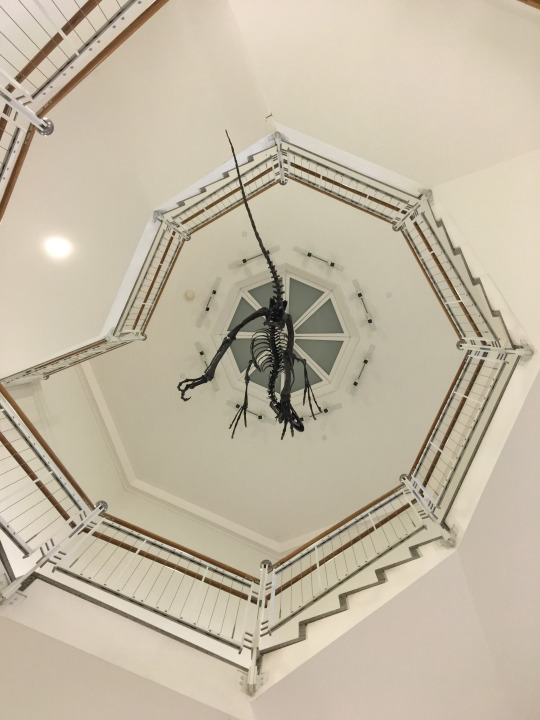
Deinonychus antirrhopus
New Haven, CT.
Suspended above in the foyer of the Yale Museum of Natural History is a skeletal reconstruction of the "raptor" Deinonychus in a leaping attack posture. Yale paleontologist John Ostrom's landmark papers on this lightly built and agile predator inspired a revolution in how we think about extinct dinosaurs and their living descendants, the birds. The name Deinonychus refers to the sickle-like daw on its foot that, together with its hook-like hand claws and sharp, serrated teeth, would have made for a fearsome predator indeed. Although once thought to have been a cooperative pack hunter, recent work by paleontologists at Yale indicates that it was more likely a solitary predator and cannibal. Deinonychus was the role model for its smaller cousin Velociraptor, the star of the best-selling book and blockbuster film Junasoic Park. Author Michael Crichton and filmmaker Steven Spielberg referred to Ostrom's scientific papers when creating their terrifying "raptors." Ostrom's 1964 discovery of the fossil specimens on which this cast is based heralded the "Dinosaur Renaissance." Extinct dinosaurs were then commonly thought of as sluggish, scaly, overgrown reptiles similar to living crocodiles. Ostrom's studies led scientists to see that most features of living birds, including a hot-blooded active lifestyle, and even feathers and flight, actually arose much earlier in dinosaur evolution. Ostrom showed that Deinonychus was remarkably similar to another fossil, Archaeopteryx, and thus to living birds, cementing the genealogical connection between what had long been seen as two very different groups of animals. Although Deinonychus was much too heavy and its arms far too short to permit flight, it still had striking modifications to its shoulders, arms, and hands that are important flight-related adaptations in living birds. This enabled scientists to see how the avian flight stroke evolved from the predatory raptorial grasp of extinct dinosaurs like Deinonychus. Deinonychus antirrhopus means "terrible claw [with the] counter-balancing [tail]". It lived in what is now the western United States between 115 and 108 million years ago, and would have weighted around 150 pounds (almost 70 kg).
1 note
·
View note
Text

You called Master?
#stillephotos#dinosaurs#velociraptor#iguanodon#Moab Giants#deinonychus antirrhopus#camptosaurus dispar
8 notes
·
View notes
Photo

Retro vs Modern #21: Deinonychus antirrhopus
Deinonychus antirrhopus was one of the most significant dinosaur discoveries of the 20th century, kicking off the Dinosaur Renaissance and the recognition of the evolutionary link between maniraptoran theropods and modern birds.
1960s
The first remains of this species were discovered in North America in the 1930s, but at the time the fossils weren't officially described or named. It wasn't until the 1960s that more specimens were found in Montana, representing at least three preserved individuals, and paleontologist John Ostrom recognized that there was something very special about this dinosaur.
In contrast to the prevailing view at the time that theropods were all upright tail-dragging "sluggish lizards" this was clearly a highly specialized and active predator, with a huge sickle-shaped claw on each foot and a long stiff tail for balance – inspiring its scientific name's meaning of "counterbalancing terrible claw".
And while the very first reconstruction of Deinonychus might seem retro to modern eyes, at the time it was revolutionary and it went on to become an iconic representation of the species for the next couple of decades. Drawn by Robert Bakker, who was Ostrom's student at the time, it depicted a lizard-like creature with its body held in a horizontal pose and its tail held out straight behind it. Its head was portrayed as more domed than we now know Deinonychus' skull to have been, and its neck was up in an alert posture while the animal ran at full sprint, with its sickle-claws held up away from the ground to keep them sharp.
A few years later further discoveries showed a highly bird-like pelvis and hands very similar to those of Archaeopteryx, triggering the Dinosaur Renaissance reinterpretation of dinosaurs as active warm-blooded animals, and the revival of the 19th century idea that they were the ancestors of birds.
1980s-1990s
As the "birds are dinosaurs" idea began to gain acceptance with increasing amounts of anatomical evidence, some paleontologists in the 1980s began to also suspect that highly bird-like dromaeosaurids like Deinonychus might have also been feathered. Some reconstructions during this time showed this to varying degrees, particularly those drawn by Bakker and by Gregory Paul – but it didn't really catch on more widely at first, for one very big reason:
Jurassic Park happened.
Dromaeosaurs hadn't been well-known dinosaurs to the general public before that point, but the 1993 JP "raptors" were an instant hit in pop culture. Physically based much more on Deinonychus than on Velociraptor, and exemplifying the renaissance view of dinosaurs in major media for the first time, the movie's fully scaled and oversized version of these animals dominated popular depictions for years afterwards. Even the most rigorous and anatomically accurate artwork showcasing their bird-like features still usually kept them completely naked to retain that familiar reptilian appearance.
Most 1990s attempts at any feathering tended towards being as sparse as possible – often along with the shrinkwrapping typical for the era – at best being decent for the time but what we'd now deride as "half-assed", and at worst being "a few token quills on the back of the head".
Deinonychus fossils found in association with Tenontosaurus were also interpreted as being evidence of cooperative pack hunting behavior during this time, and it became a common paleoart meme to depict the large herbivore being constantly swarmed by ravenous raptors.
2020s
The mid-1990s discovery of fully-feathered dinosaurs like Sinosauropteryx in China, followed a few years later by raptors with wing-feathered arms like Sinornithosaurus, gradually began to put the fluff back onto dinosaurs like Deinonychus.
(…At least in reasonably scientific paleoart. The much much stronger and ongoing resistance from popular culture is far too big a subject to get into here. But maybe, just maybe, we're finally hitting a turning point there?)
Early attempts at properly feathering dinosaurs were a bit awkward, usually looking rather like a bunch of scruffy greasy hair glued onto a scaly raptor, a dinosaur wearing fuzzy pajamas, or like the old "bird-lizard" depictions of Archaeopteryx. Even into the early 2010s some paleoart memes were still common in depictions of dromaeosaurs, but increasingly better understanding of their anatomy and plumage arrangements over the last decade or so has brought us to a much more birdlike interpretation of these animals – with paleoartists like Emily Willoughby being especially influential in popularizing the modern view of dinosaurs like Deinonychus.
We now know Deinonychus lived during the Early Cretaceous, about 115-108 million years ago, in what is now the Mountain West and South Central United States. Up to around 3.4m long (11'), it stood about 1m tall (3'3"), similar in size to a large dog.
It had blade-like teeth in its jaws, and forward-facing eyes with stereoscopic vision. Its three-fingered arms would have been covered by wing-like feathers, and its tail probably had feathers all the way along its length and was stiffened but not totally inflexible.
It may have used the sickle-claws on its feet to pin down struggling prey, eating it alive while flapping its wings and waving its tail for balance. And while often depicted as an extremely fast-runner, its leg proportions and foot anatomy suggest it was actually built more for walking and had an especially strong grip strength in its feet, trading speed for power and probably being more of an ambush predator – often being compared to a "giant ground-hawk".
Pack hunting has been called into question recently, too, arguing that the Tenontosaurus sites may actually represent crocodile-like or Komodo dragon-like behavior with mobs of scavenging individuals congregating at a carcass. But other evidence from trackways and Utahraptor does offer potential support for pack behavior in raptors, so it's still open to interpretation.
———
Nix Illustration | Tumblr | Twitter | Patreon
#retro vs modern 2022#science illustration#paleontology#paleoart#palaeoblr#deinonychus#dromaeosaur#raptor#maniraptora#theropod#dinosaur#actual pointy birbs#art#retrosaurs#'and then jurassic park happened' is the theme of the final three entries in this series
3K notes
·
View notes
Note
please tell me everything about something you are very very normal about
im sure you were expecting a blorbo or something but youre going to hear about biology now anon.
im just gonna share a bunch of animals i like :] warning for insects, arachnids, and other creatures

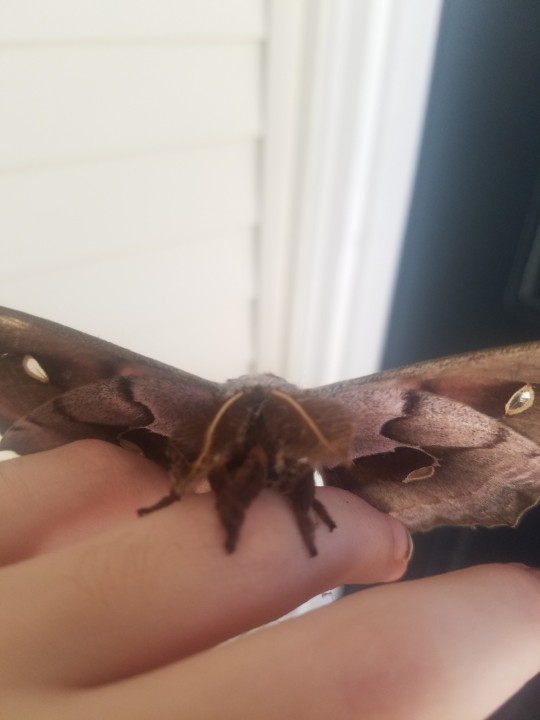
lets start with this. this is a polyphemus moth! (Antheraea polyphemus) belonging to family saturniidae (giant silk moths) which s known for having some of the largest moth species in the world!! including THE largest species the atlas moth (Attacus atlas) but this aint about him. these photos are of a pair i found that had likely mated shortly before this! the female (left) was eggbound :] you can tell which one is female ans which one is male by the antennae!! females will have smooth antennae and males antennae are covered in that like. feather like shit. males use this to pick up the females pheromones :]]

heres another moth i found!! this little fella is an alianthus webworm moth (Atteva aurea,) arent their patterns gorgeous? :]
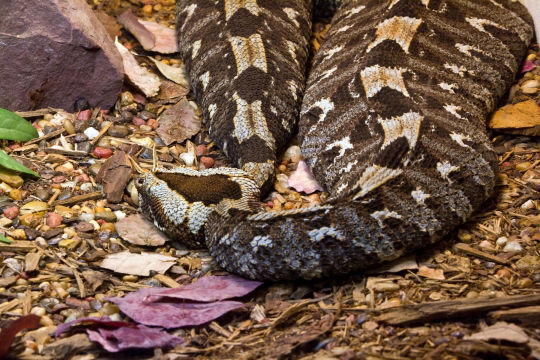
this is my favorite snake!! the rhinoceros viper (Bitis nasicornis,) with such beautiful coloring, the little horns on their nose, the fat fuck friday swag, and everything else these guys are just Flawless. also i have a plush of one named lightning! you can find a photo of him in my pinned post :] rhino viper fun fact! theres a species in the same genus called Bitis rhinoceros and yet that one ISNT the rhinoceros viper. isnt this shit crasy.

this fella is a thresher shark! specifically Alopias pelagicus, the pelagic thresher. there are three extant species of thresher shark and ill admit im not actually too familiar with them! but i DO like treshers as a whole! they use their long tail fin to whip shit. thats fucking awesome. i saw a thresher at an aquarium when i was a little kid and i was so scared it was so funny. thats why theyre my favorite shark now :]


these are eastern pondhawks! Erythemis simplicicollis, now i HAVE seen these in person but i cant find my old photos of them :( the color variation you see here is sexual dimorphism! the females are that beautiful green color and the males are that beautiful blue color! incredible.

cobalt blue tarantula. Cyriopagopus lividus. must i say anything more. its a bright ass blue spider.

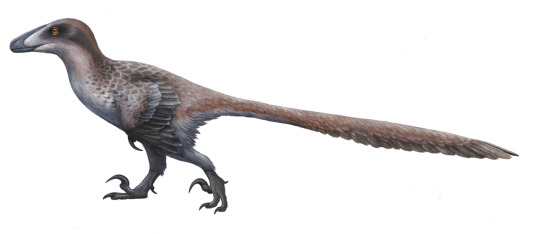
and with these ive hit my image limit! what a wonder animal to end this on, this is Deinonychus antirrhopus, a dromaeosaur (raptor!) and my personal favorite dinosaur! if im not mistaken, the "velociraptors" in jurassic park were actually based of deinonychus and not velociraptor! i dont really go there tho so please note i very well Could be mistaken. fun fact! the most well known species of velociraptor (there are two) is Velociraptor mongoliensis :]
all images that were not taken by me (everything except the polyphemus moths and alianthus webworm moth) were just grabbed from the wikipedia pages for these guys. biology so cool
#dragon cave's mailbox#insect cw#bug cw#spider cw#guy who is normal.#i have a map of evolution framed on my wall.#from kurzgesagt is anyone reading this is familiar with their content lol
8 notes
·
View notes
Text

Often lauded as the real inspiration for the JP Raptors™, Deinonychus antirrhopus is bigger and bulkier than it’s Asian relative Velociraptor, but still very different from its movie monster “twin.”
Deinonychus was first discovered in 1931, but it wasn’t until more material was discovered in the 60s and paleontologist John Ostrom completed a study on the animal in 1969, that Deinonychus revolutionized the way scientists thought of dinosaurs. Long thought to be giant, slow, plodding monsters, Deinonychus seemed to be sleek, agile, and active, with a horizontal posture and raptorial birdlike claws. This development in paleontology has been deemed the “dinosaur renaissance” and is regarded as one of the most important discoveries in dinosaur paleontology.
This discovery of birdlike agility and behavior in dinosaurs led author Michael Crichton to write his Jurassic Park novels, featuring these new swift killers as the antagonists. Crichton even met with John Ostrom several times to discuss the behaviors and appearance of his raptors. However, with apologies to Ostrom, Crichton admitted to changing the name of the creatures to “Velociraptor,” as he felt the name was more dramatic. The movies based off of the books followed suit, and the rest is history.
Deinonychus lived in swamp-like habitats of Cretaceous U.S.A, and remains have been found in Montana, Utah, Wyoming, and Oklahoma, as well as possible teeth found as far east as Maryland. It could grow up to 3.4 meters (11 ft) long, and would have been about as tall as a Great Dane. Their “killing claws,” when reconstructed with a sheath over the bone (as in birds and crocodilians), are estimated to have been 120 millimetres (4.7 in) long.
Deinonychus teeth and other fossils are often found in association with the ornithopod Tenontosaurus, suggesting it may have hunted them. However, the horse-sized Tenontosaurus were much larger and heavier than the dog-sized predator. This, along with Deinonychus fossils usually being found together with other Deinonychus, suggest that the raptor may have hunted in groups, or at least in pairs. However, this could also be evidence that the raptors simply scavenged these large carcasses, and merely tolerated each others’ presence.
While Deinonychus are typically presented in media as unusually fast (and, yes, they would have been faster than what was previously thought capable for dinosaurs) their leg anatomy was not built for speed and they would not have been able to outrun modern flightless dinosaurs such as ostriches and emus.
Along with Tenontosaurus, Deinonychus would have lived alongside the nodosaur Sauropelta, the small ornithischian Zephyrosaurus, and the crocodilians Goniopholis and Paluxysuchus. In Oklahoma, it would have had to look out for Acrocanthosaurus and the giant sauropod Sauroposeidon.
#it’s sideways cause I wanted to fit more of it in my typical 1000 x 1000 box for these#my art#SaritaDrawsPalaeo#Deinonychus#Deinonychus antirrhopus#dromeosaur#raptor#theropods#dinosaurs#archosaurs
36 notes
·
View notes
Text
Pyroraptor olympius
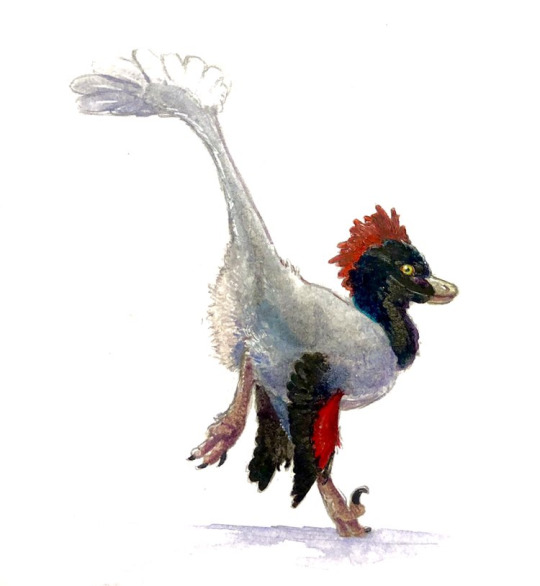
By Ripley Cook
Etymology: Fire Thief
First Described By: Allain & Taquet, 2000
Classification: Dinosauromorpha, Dinosauriformes, Dracohors, Dinosauria, Saurischia, Eusaurischia, Theropoda, Neotheropoda, Averostra, Tetanurae, Orionides, Avetheropoda, Coelurosauria, Tyrannoraptora, Maniraptoromorpha, Maniraptoriformes, Maniraptora, Pennaraptora, Paraves, Eumaniraptora, Dromaeosauridae
Status: Extinct
Time and Place: Around 72 million years ago, in the Campanian of the Late Cretaceous


Pyroraptor is known from the La Boucharde locality in France, the Vitoria and La Posa Formations in Spain, and potential locations in the UK
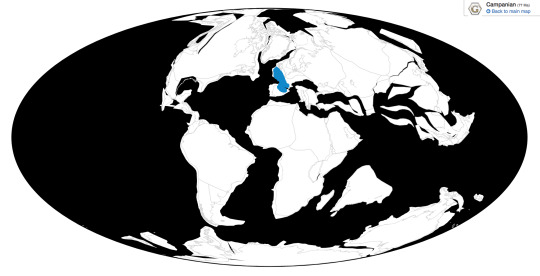
Physical Description: Pyroraptor is a poorly known raptor, based on a few fossil scraps found around the late Cretaceous of Europe. Portions of the foot, arms, and some teeth are known from Pyroraptor, none preserved very well. It had the sickle second toe claw of other raptors, and it seems to have been fairly lightweight and small - probably no longer than 1.4 meters, though that is of course an estimate. Other than that, we know very little about its appearance - we don’t even know if it was a specialized sort of raptor like in the Dromaeosaurine, Microraptorine, or other groups - except for that it would have been very fluffy, with wings on its arms and a tail fan on its tail.
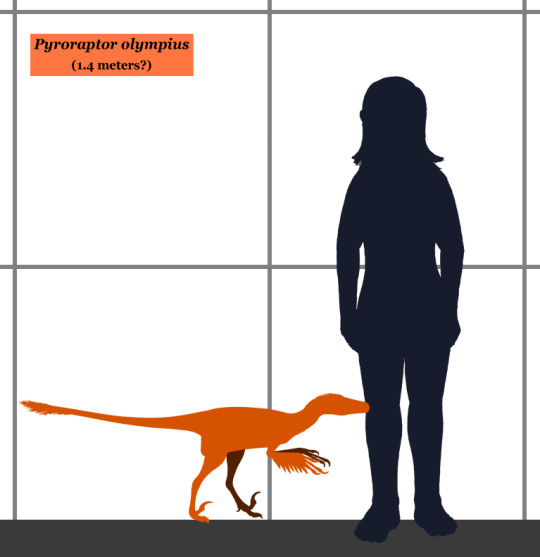
By Conty, CC BY 3.0
Diet: As a raptor, it is most likely that Pyroraptor fed upon meat, probably small animals such as lizards, mammals, and turtles.
Behavior: Pyroraptor would have been a very active dinosaur, spending most of its time hopping and stalking around the rivers and beaches in its island environment. Like other raptors, it wouldn’t have been a pursuit predator, but rather an ambush one: it would have waited for prey to appear, and then pounced on it, using rapid flaps of its wings to stay balanced on top of the struggling prey. This technique, called raptor prey restraint, is still seen in living raptors today. Pyroraptor would have also been able to run up vertical surfaces, such as trees and cliffs, using flaps of its wings to gain lyft up the surface. Then, it would have been able to catch food on the run! Other than that, Pyroraptor probably wasn’t very social, based on fossil evidence from other raptors - that being said, it would have taken care of its young, and probably stayed in small family groups during this process.
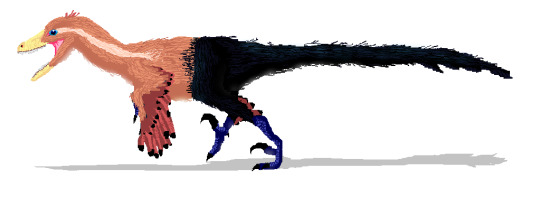
By The Unknown Horror From the Ocean Depths, CC BY-SA 4.0
Ecosystem: Pyroraptor lived in the Late Cretaceous of Western Europe, which was a series of islands sitting in a shallow ocean - sort of like the Bahamas today. These ecosystems were easy to travel between, utilizing rafting and other forms of impromptu sea travel, so the animals on them tended to be similar to each other. Pyroraptor itself lived with many turtles, snakes, sharks, and gars; as well as Eusuchians such as Musturzabalsuchus and Acynodon. There was some sort of large Azhdarchid pterosaur, too - currently called Azhdarcho, though that’s a questionable assignment. As for other dinosaurs, there were Abelisaurids there, Titanosaurs like Lirainosaurus, Nodosaurids like Struthiosaurus, the Ornithopod Rhabdodon, and another raptor called Richardoestesia, and the protobird Gargantuavis!

By José Carlos Cortés
Other: Pyroraptor was named as such because it was discovered after the occurence of a forest fire. Since so little is known about this dinosaur, there isn’t much more to be said about its phylogenetics or history of discovery! It is rather famous for having been featured in the 2003 documentary Dinosaur Planet, though given its poorly preserved nature, the wisdom in that choice of star is mildly suspect.
~ By Meig Dickson
Sources Under the Cut
Allain, R. and P. Taquet. 2000. A new genus of Dromaeosauridae (Dinosauria, Theropoda) from the Upper Cretaceous of France. Journal of Vertebrate Paleontology 20(2):404-407
Allain, R., and X. Pereda Suberbiola. 2003. Dinosaurs of France. Comptes Rendus Palevol 2:27-44
Angst, D., E. Buffetaut, J. C. Corral and X. Pereda-Suberbiola. 2017. First record of the Late Cretaceous giant bird Gargantuavis philoinos from the Iberian Peninsula. Annales de Paléontologie
Astibia, H., E. Buffetaut, A. D. Buscalioni, H. Cappetta, C. Corral, R. Estes, F. Garcia-Garmilla, J. J. Jaeger, E. Jiminez-Fuentes, J. Le Loeuff, J. M. Mazin, X. Orue-Etexebarria, J. Pereda-Suberbiola, J. E. Powell, J. C. Rage, J. Rodriguez-Lazaro, J. L. Sanz and H. Tong. 1990. The fossil vertebrates from the Lano (Basque Country, Spain); new evidence on the composition and affinities of the Late Cretaceous continental faunas of Europe. Terra Nova 2:460-466
Carpenter, K. (1998). "Evidence of predatory behavior by theropod dinosaurs". Gaia. 15: 135–144.
Carpenter, K. 2002. Forelimb biomechanics of nonavian theropod dinosaurs in predation. Senckenbergiana Lethaea 82: 59 - 76.
Carrano, M. T., and S. D. Sampson. 2008. The phylogeny of Ceratosauria (Dinosauria: Theropoda). Journal of Systematic Palaeontology 6(2):183-236
Chanthasit, P., and E. Buffetaut. 2009. New data on the Dromaeosauridae (Dinosauria: Theropoda) from the Late Cretaceous of southern France. Bulletin de la Société Géologique de France 180(2):145-154
Delcourt, R., and O. N. Grillo. 2014. On maniraptoran material (Dinosauria: Theropoda) from Vale do Rio do Peixe Formation, Bauru Group, Brazil. Revista Brasileira de Paleontologia 17(3):307-316
Erickson, G. M., K. Curry Rogers, D. J. Varricchio, M. A. Norell, X. Xu. 2007. Growth patterns in brooding dinosaurs reveals the timing of sexual maturity in non-avian dinosaurs and genesis of the avian condition. Biology Letters 3 (5): 558 - 61.
Fowler, D. W., E. A. Freedman, J. B. Scannella, R. E. Kambic. 2011. The Predatory Ecology of Deinonychus and the Origin of Flapping in Birds. PLoS ONE 6 (12): e28964.
Gauthier, J., K. Padian. 1985. Phylogenetic, Functional, and Aerodynamic Analyses of the Origin of Birds and their Flight. Hecht, M. K., J. H. Ostrom, G. Viohl, P. Wellnhofer (ed.). The Beginnings of Birds. Proceedings of the International Archaeopteryx Conference, Eichstätt: Freunde des Jura-Museums Eichstätt: 185 - 197.
Gishlick, A. D. 2001. The function of the manus and forelimb of Deinonychus antirrhopus and its importance for the origin of avian flight. In Gauthier, J., L. F. Gall. New Perspectives on the Origin and Early Evolution of Birds. New Haven: Yale Peabody Museum: 301 - 318.
Godefroit, P., P. J. Currie, H. Li, C. Y. Shang, and Z.-M. Dong. 2008. A new species of Velociraptor (Dinosauria: Dromaeosauridae) from the Upper Cretaceous of northern China. Journal of Vertebrate Paleontology 28(2):432-438
López-Martínez, N. 2000. Eggshell sites from the Cretaceous-Tertiary transition in south-central Pyrenees (Spain). In A. M. Bravo & T. Reyes (ed.), First International Symposium on Dinosaur Eggs and Babies, Extended Abstracts 95-115
Manning, Phil L., Payne, David., Pennicott, John., Barrett, Paul M., Ennos, Roland A. (2005) "Dinosaur killer claws or climbing crampons?" Biology Letters (2006) 2; pg. 110-112.
Martyniuk, M. 2016. You’re Doing It Wrong: Microraptor Tails and Mini-Wings. DinoGoss Blog.
Pereda-Suberbiola, X., H. Asibia, X. Murelaga, J. J. Elzorza, and J. J. Gomez-Alday. 2000. Taphonomy of the Late Cretaceous dinosaur-bearing beds of the Lano Quarry (Iberian Peninsula). Palaeogeography, Palaeoclimatology, Palaeoecology 157:247-275
Prum, R.; Brush, A.H. (2002). “The evolutionary origin and diversification of feathers”. The Quarterly Review of Biology. 77 (3): 261–295.
Rothschild, B., Tanke, D. H., and Ford, T. L., 2001, Theropod stress fractures and tendon avulsions as a clue to activity: In: Mesozoic Vertebrate Life, edited by Tanke, D. H., and Carpenter, K., Indiana University Press, p. 331-336.
Senter, P., R. Barsbold, B. B. Britt and D. A. Burnham. 2004. Systematics and evolution of Dromaeosauridae (Dinosauria, Theropoda). Bulletin of the Gunma Museum of Natural History 8:1-20
Torices Hernández, A. 2002. Los dinosaurios terópodos del Cretácico Superior de la Cuenca de Tremp (Pirineos Sur-Centrales, Lleida). Coloquios de Paleontología 53:139-146
Torices, A., P. J. Currie, J. I. Canudo and X. Pereda-Suberbiola. 2015. Theropod dinosaurs from the Upper Cretaceous of the South Pyrenees Basin of Spain. Acta Palaeontologica Polonica 60(3):611-626
Turner, Alan H.; Pol, D.; Clarke, J.A.; Erickson, G.M.; Norell, M. (2007). “A basal dromaeosaurid and size evolution preceding avian flight”. Science. 317 (5843): 1378–1381.
Turner, AH; Makovicky, PJ; Norell, MA (2007). “Feather quill knobs in the dinosaur Velociraptor”. Science. 317 (5845): 1721.
Vila, B., M. Suñer, A. Santos-Cubedo, J. I. Canudo, B. Poza and A. Galobart. 2011. Saurischians through time. In A. Galobart, M. Suñer, & B. Poza (eds.), Dinosaurs of Eastern Iberia 130-168
Weishampel, David B.; Dodson, Peter; and Osmólska, Halszka (eds.): The Dinosauria, 2nd, Berkeley: University of California Press. 861 pp.
Xu, X.; Zhou, Z.; Wang, X.; Kuang, X.; Zhang, F.; Du, X. (2003). “Four-winged dinosaurs from China”. Nature. 421 (6921): 335–340.
#Pyroraptor olympius#Pyroraptor#Raptor#Dinosaur#Bird#Birblr#Palaeoblr#Dromaeosaur#Dinosaurs#Factfile#Birds#Cretaceous#Eurasia#Carnivore#Theropod Thursday#paleontology#prehistory#prehistoric life#biology#a dinosaur a day#a-dinosaur-a-day#dinosaur of the day#dinosaur-of-the-day#science#nature#Feathered Dinosaurs
386 notes
·
View notes